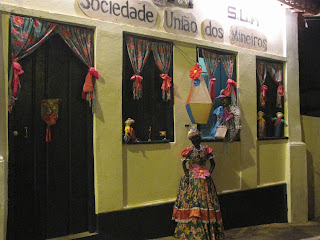After some negotiations with Paulo, the guide, and a few days of waiting to see if we could find a couple more hikers we decided to go for a 2 night 3 day trek with just the three of us.
We headed off in Paulo's new car to a small rural town called Guine. Here we bought some supplies for the trek. The town was spotlessly clean and charmingly decorated with curtains outside the windows.
We headed off in Paulo's new car to a small rural town called Guine. Here we bought some supplies for the trek. The town was spotlessly clean and charmingly decorated with curtains outside the windows.
And a great mural.
Pastel coloured houses face the main street.
Ready to head out. Paulo was so considerate to bring me a stick!
Heading for the bluff and it is up up up!
Looking back where we have come from.
Quite a few flowering plants about.
And some cactuses.
Lunch break at Crocodile Rock
The camp in the distance that can have 150 people stay in peak season. It has solar powered lights and a fridge.
The path to get there.
Met some other hikers at the viewpoint who wanted
me to have their stick and pose for them!
Watching the sunset while Paulo cooks dorado fish for dinner.
Our room for the night. The night was pretty cold but we were amazingly cosy in the mud brick room under two blankets after a cold shower.
This snake kindly posed for us before slithering off into the grass.
This guy looked like a thin dry branch in the middle of the track.It would have been about a metre and a half long with a curled up tail and a yellowish belly. He slithered up into the long grass and would have been at eye height when photographed.
The Cachoerao Falls but they were dry! The highest falls in Brazil. Spent some time resting here while Paulo organised lunch. Temperatures were between 32 and 34 degrees. It was 9 kilometres to this point.
One more snake on the way home.
Another view point. A man with a backpack full of supplies for the camp shop owner passed us walking the trail in his Havianas. He gets paid 100 Reis per load. The camp owner has mules he uses to get supplies as well and a lot of the track we walked was rutted out by the mules hooves and quite slippery.
John and Paulo at Pai Inacio on the way back to Lencois.























































